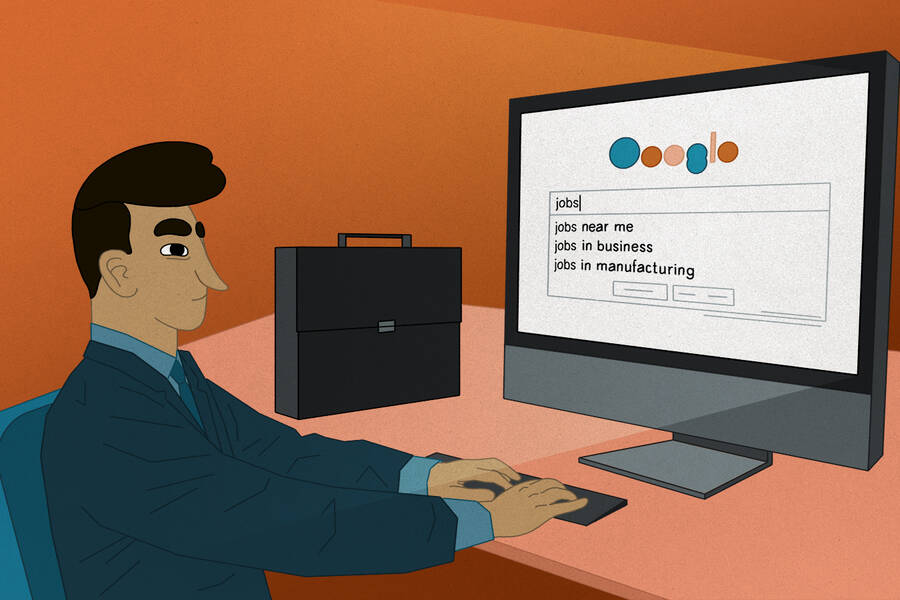
Lisa Röper
In light of the economic devastation caused by the coronavirus pandemic, Congress has earmarked trillions of dollars for stimulus checks, expanded unemployment insurance, and offered loans to small businesses. Many Americans considered these moves necessary to stave off collapse. But Dimitris Papanikolaou, a professor of finance at Kellogg, fears those trillions are not necessarily addressing the true source of the economic turmoil.
“I was stunned by a lot of the responses from policymakers,” Papanikolaou says. “They’re addressing secondary effects—and by secondary I don’t mean that they’re smaller, necessarily, but they were not the root cause of the problem.”
Papanikolaou thinks of the COVID-related economic crisis as a swift domino reaction, beginning with an initial supply shock, wherein large sectors of the economy were forced to shutter in an effort to contain the pandemic. The next domino to fall was the demand-side shock, in which many Americans who had lost their income had to cut down on spending and struggled to pay their mortgages and credit-card debt. This, in turn, forced banks to reduce lending.
So, if aid packages had managed to keep the first domino from falling quite so hard, the overall economic impact might have been much smaller. And, given that more economic restrictions may be needed to contain a “second wave” of COVID-19 infections, policymakers can minimize the harmful ripple effect by targeting those sectors and businesses likely to suffer most at the outset—but only if they know which sectors to target.
In a new paper, Papanikolaou and Lawrence Schmidt, an assistant professor of finance at MIT’s Sloan School of Management, examined the impact of the initial supply-side shock of COVID-19 on various sectors. As it turns out, the impact of COVID varied significantly based on a sector’s work-from-home friendliness.
“Our starting point was, if workers can work from home, then firms can basically keep doing what they were doing,” Papanikolaou says. “Whereas, if they need to have physical contact either to produce things or sell things, then this is going to lead to massive disruptions.”
Sectors in which few employees have historically worked from home have fared significantly worse since the COVID-induced shutdown began: businesses in these sectors experienced greater declines in employment and expected revenue growth; worse stock market performance; and higher likelihood of defaulting on payments.
But even within a given sector, the suffering is not shared equally among workers. Remote-unfriendly jobs are especially harmful to the employment prospects of women and lower earners, for example, meaning that COVID-19 stands to undo hard-earned gains for subsets of the workforce that have historically been underrepresented.
Quantifying the Cost of Being Unable to Work from Home
To pinpoint the parts of the workforce that are most and least amenable to a work-from-home setup, Papanikolaou and Schmidt turned to the American Time Use Surveys for 2017 and 2018.
Among other things, the surveys asked workers if there are days when they work only at home. The researchers argue that the portion of workers in a given industry who answered yes to that question is likely a good proxy for how easily that industry was able to migrate to remote work when COVID-19 struck.
“I think it’s possible that this could reverse the gains in employment and wage growth among women that have happened over the last five or ten years.”
According to these surveys, industries vary significantly in terms of the share of workers that can perform their duties from home—only 3 percent of employees in transportation and material moving are able to work fully remotely, for example, compared to 78 percent of computer programmers.
To measure how work-from-home friendliness affected outcomes during the pandemic, the researchers analyzed two measures of economic health.
First, they looked at employment levels across sectors and by individual workers’ demographic characteristics, pulling employment data from two sources, the Bureau of Labor Statistics (for the sector-level analysis) and the Current Population Survey (which provides individual workers’ occupation and demographic characteristics, including gender, education level, dependent information, and earnings). They used the data to compare April 2020 employment numbers for each industry to pre-pandemic levels.
Second, they examined firm-level health. Specifically, Papanikolaou and Schmidt looked at the stock performance of publicly traded firms, as well as how financial analysts had revised forecasts of expected revenue growth and firms’ likelihood of default (calculated daily for public firms by the Risk Management Institute of the National University of Singapore).
The Unequal Distribution of the COVID-19 Supply Shock
The researchers found that the economic impact from the initial shock of shutting down the economy varied significantly across sectors.
Unsurprisingly, sectors in which fewer employees could work remotely experienced greater drops in employment. A one-standard-deviation increase in the share of workers unable to work from home corresponded with a 7 percent decline in employment within an industry.
When the researchers restricted their sample to sectors deemed “noncritical” (to avoid counting businesses like grocery stores, which were allowed to maintain operations even though most workers cannot perform their duties remotely), the differences were even starker: a one-standard-deviation increase in the share of workers who couldn’t work remotely was associated with a 10 percent drop in employment.
Papanikolaou and Schmidt also found that relative ease of working remotely also had outsize effects on certain demographic groups. For women and low-earners, in particular, having a more remote-unfriendly job was associated with a larger drop in employment.
But one group of workers was especially vulnerable to the adverse effects: women with young children and without a college degree. Among this group, a decrease in remote-friendliness led the probability of employment to fall by three times as much as among the general workforce.
“I think it’s possible that this could reverse the gains in employment and wage growth among women that have happened over the last five or ten years,” Papanikolaou says.
Papanikolaou thinks that the pandemic is likely to worsen income disparities, too, since workers who lose their jobs may suffer permanent income losses—and many lower-paid workers are clustered in certain sectors. “The pandemic has hit the service sector the hardest, which is also the sector employing a disproportionate number of blue-collar workers, especially women, without a college degree,” he says.
And the same sectors that suffered greater employment loss also had bleaker prognoses. A one-standard-deviation increase in the share of workers unable to go remote led to an 8 percent decline in analyst revenue forecasts for the second quarter of 2020, a 0.22 percent increase in the probability of default in the next six months, and a 7 percent decline in stock-market performance.
The Danger of Betting on Industries That Can’t Work from Home
Given that a sector’s capacity for remote work was so closely connected to its economic outcomes, Papanikolaou and Schmidt wanted to get a sense of how the shock to industries not conducive to working from home might reverberate through the economy at large.
So they built a stock portfolio that overweighed industries less friendly to remote work and underweighed those that are more friendly. The idea was to quantify how much a portfolio would underperform the market if it was maximally exposed to work-from-home unsuitability.
“This doesn’t mean that working from home is necessarily more productive than working in the office; it’s simply more productive than not working at all.”
Papanikolaou says this step not only provided another perspective on the real-time economic costs of the pandemic, but also offered a model for how an investor might try to hedge a portfolio against some of the economic impacts at play. “If an investor wanted to buy insurance to protect against these types of shocks, or bet either for or against a recovery, what type of investment strategy should she follow? We wanted to look into that,” Papanikolaou says.
As predicted, this remote-work-unfriendly portfolio appeared to successfully capture a highly vulnerable swath of the economy. It had lost approximately 35 percent of its value between the beginning of the year and June 15, compared to a loss of less than 10 percent for the broader market.
How Future Aid Packages Can Send Support Where It’s Needed Most
The United States’ Paycheck Protection Program (PPP) arrived rapidly and almost surely helped to mitigate disruptions in the economy. However, this policy treated all firms similarly despite the fact that not every sector was affected the same.
Papanikolaou believes his results can, and should, help target future aid packages that seek to prop up the U.S. economy as the pandemic drags on. For one thing, he says, aid should go to the businesses that need it most—and his research suggests which businesses those are.
For example, the sector that received the largest number of PPP loans and the second-highest total amount of funding was “Professional and Technical Services” with 589,000 loans totaling approximately $65B. According to Papanikolalou and Schmidt, this sector has the highest fraction of workers who can work remotely and thus is one of those least exposed to the disruptions associated with the pandemic.
Yet this sector received more than $12,500 per employee in PPP loans. Meanwhile, the much harder-hit “Accommodation and Food Services” sector received just $4,800 per person, and “Arts, Entertainment, and Recreation” received $5,400.
“Overall, I think having a sense of which sectors were more exposed gives you the ability to have a more targeted response,“ he says. That is, shifting the marginal dollar from industries less affected by the pandemic (for instance, the “Professional and Technical Services” sector) to industries significantly more affected (such as, the “Accommodation and Food Services” and “Arts, Entertainment, and Recreation” categories) could provide much more effective insurance.
Papanikolaou was somewhat surprised that amenability to remote work proved such a strong predictor of the firms that are struggling and those that aren’t. “Working from home must be more effective than I thought, at least,” he says. “For me personally, it’s true that I can work from home with certain compromises, but to be honest, I would prefer to be in an office environment, because my productivity would be much higher.”
But he stops short of speculating that this means companies should abandon their offices and fully embrace work-from-home culture.
“This doesn’t mean that working from home is necessarily more productive than working in the office; it’s simply more productive than not working at all.”



